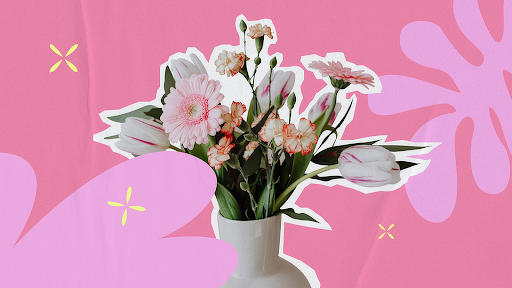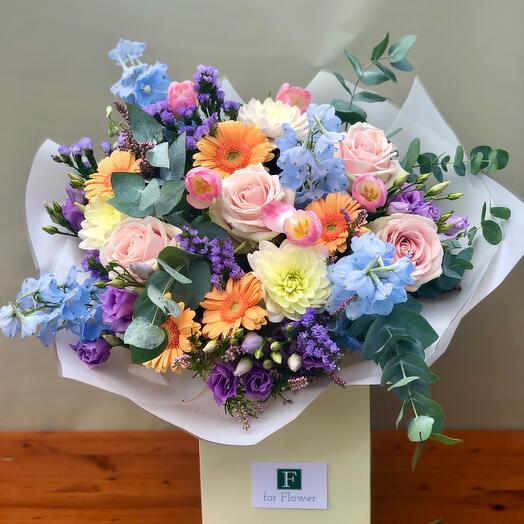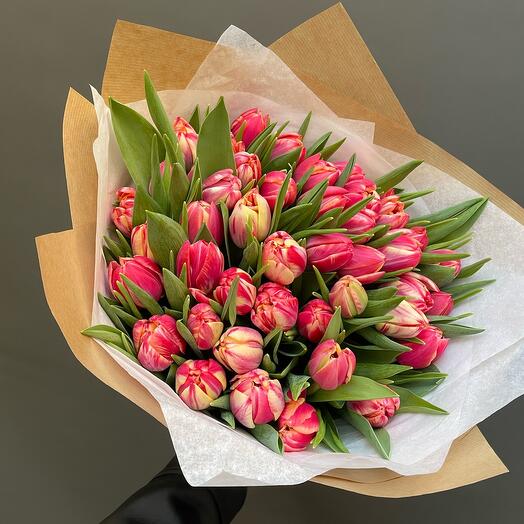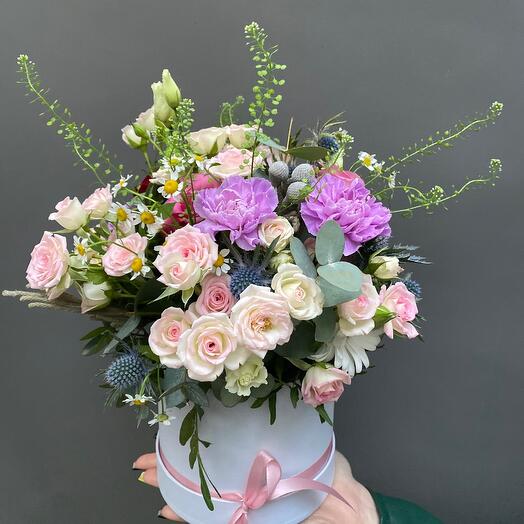
It's nearly impossible to resist the allure of an exquisite bouquet, would you agree? Given their wide range of hues, shapes, and appealing aromas, flowers always work as perfect gifts. However, as much as we adore these beauties, there is a simple fact not to be forgotten – every bouquet has its own care standards to flourish at home. If you need a trustworthy way of ensuring that your flower delivery isn’t wasted, use these handy tips on how to keep flowers fresh in a vase without unnecessary hassle.
Why do cut flowers need our care?
First and foremost, let’s refer to the fundamentals. The basic rule is based on a simple natural fact: once the stem has been cut, it no longer has access to the minerals it usually receives. This means its vitality will slowly be lost. Therefore, as caretakers, we should focus on providing the key supplements and establishing the environment required for retaining freshness and liveliness.
How to keep flowers fresh after buying
Once you bring a new floral present into your home, it’s inevitable to start searching for the top-notch care routine. Although it may appear a tad intimidating at first, it is much easier to fulfil the tips we give all at once to prolong the bouquet’s life. So, here is the universal instruction on how to keep flowers fresh:
1. Remove the packaging
Any wrapping or packaging, especially if made of plastic, should always be disposed of before anything else is to be done. Removing any restrictive wrap is absolutely essential since the wrap might be preventing your flowers from breathing freely.
2. Cut the stems
The next step is finding a 45-degree angle to cut the stems appropriately. Although shears are the best option, a pair of scissors or a knife would also fit. This is your number-one method for creating a surface area on a stem that is large enough for the best water absorption. The flowers won't have any option but stay extra fresh if the procedure is repeated once every couple of days.
3. Cut back any extra leaves
Now, trim all leaves at the bottom of the stems that will end up under the waterline. After placing a bouquet in a vase, submerged organics become a breeding ground for microorganisms. These microorganisms are the primary catalyst for the flower’s rapid wilting.
4. Find a vase of the correct size
Each bouquet needs a fitting vase to truly showcase its glory. A small vessel never contains enough water, while a huge one fails to support the flowers in the upright position. The arrangement should remain vertical, with some space left between the buds.
How to keep flowers fresh in a vase for a longer time
Now, let’s answer the ever-pressing question: how to keep fresh flowers longer? Frankly, there is no magic solution: simply provide these live creatures – the flowers – with nutrients, helping them remain crispy-fresh and eye-catching. After finding the right location, sheltered from direct sun rays or heating appliances, follow our steps to maintain vitality and magnificence.

Feed your flowers
Flower bouquets require proper nutrition that provides vital nutrients and prevents wilting. While it is convenient to buy such supplements at any floral or gardening store, it is also quite easy to prepare your own mix.
How to make your own flower food
Take a look at these most common solutions:
a teaspoon of sugar + a teaspoon of bleach + 2 teaspoons of lemon or lime juice
a part of Sprite + a few drops of bleach
a crushed aspirin tablet
2 tablespoons of sugar + a tablespoon of vinegar
¼ teaspoon bleach
Specifics of caring for flowers by species
Roses
Classic roses are delicate and require regular attention. When tending to roses, it's vital to keep them in a cool, dry room. Additionally, they crave specific foods. For example, adding a tablespoon of apple cider vinegar or vodka can do wonders for any rose specimen.
Tulips
Tulips are known for their vibrant colours and sleek stems, especially enchanting in cooler temperatures. To keep tulips looking their best, store them in cool rooms away from draughts. A wonderful idea is to add cool water to the container from time to time.
Sunflowers
As the epitome of sunshine, sunflowers always thrive in a warm atmosphere. These flowers certainly benefit from being placed in a sunny spot. Mix a tablespoon of sugar into the water for an extra touch.
Peonies
Regarding peonies, we recommend purchasing them still in the bud. This way, they will bloom at home and last longer in a vase. Additionally, make sure to maintain a cool temperature of about 16-18 degrees Celsius.
Gypsophilas
Widely called "baby's breath," gypsophilas love crystal-clear, fresh water coupled with a cool environment. Similarly to tulips, they shudder at the slightest hint of draughts, so put them in rooms free of draughts.
Mistakes to avoid when looking after fresh flowers

Even though the caring process for live compositions is fairly straightforward, several common misconceptions can cause even the lushest bouquet to wilt in a flash. Here are 5 crucial mistakes to note when choosing how to keep freshly cut flowers alive longer:
Placing bouquets next to fruits
While fruit is a healthy and delicious snack, it has a harmful influence on most bouquets. For example, apples and bananas release a natural gas called ethylene, the primary cause of significantly faster flower withering. So, never forget to separate the fruit bowl and the flowers.
Settling for a vase that is tiny or gigantic
Another widespread issue is a vase that is too small. This leads to overcrowding, which is why fresh flowers lose their energy. On the other hand, a vessel that is too large can cause the flower stems to topple over. So, stick with vases proportionate to your bouquet’s size and shape.
Not pruning lower leaves
Any low-placed leaves remaining under the water are definitely not the best way to keep flowers fresh, as the following leaf decay and the multiplication of microorganisms will ultimately decrease the lifetime of your bouquet.
Using hot water straight from the tap
Although hot water is occasionally used by florists to speed up blooming, in reality, any cut flower could suffer from this approach. Hot water can damage delicate stems and accelerate the spread of bacteria that stimulate withering. Instead, use cool water after storing it in a separate vessel for 2-3 hours.
Placing flowers in bright sunlight
Despite the prevailing opinion, cut flowers don’t thrive in direct sunlight. It’s quite the opposite: if placed under the sun, they will quickly wilt. Low, indirect light is an unrivalled option for almost any bouquet.
What to put in the water to keep flowers fresh?
The simplest answer is always flower food, a combination of nutrients to keep arrangements garden-fresh and colourful for the longest time. Typically, such mixes are pre-made, found in local garden stores and flower shops. Alternatively, you can always put together a homemade solution.
How to keep flowers fresh overnight without water?
Sometimes there is just no way to get hold of a proper vase. How to keep a bouquet of flowers fresh without water? Fortunately, an immediate abundance of liquid isn’t a deal breaker for most sorts, which easily survive about 24 hours if the right conditions are provided. Once the stems are cut, wrap them tightly in a damp cloth. Then, put them in a sturdy plastic bag, seal it, and store it for no longer than 24 hours.
Final tips
Whether you come to own romantic roses or shy peonies, a long-lasting bouquet comes from the affection and cherishing dedicated by the owners. Although countless ideas on how to keep cut flowers fresh might be available online, remember that being attentive, patient, and respectful is indispensable.
FAQ
How should I prepare flowers for the vase?
First, find a sharp pair of scissors and trim the stems at a 45-degree angle. Next, remove all the lower leaves so that only the stems stay in the water. Finally, clean the vase thoroughly, and fill it up to two-thirds with cool water. Lastly, mix in the relevant flower food.
Which flower survives the longest in the vase?
Orchids, lilies, carnations, and chrysanthemums proudly share the title of ultimate champions, widely known to endure between 2 and 3 weeks of vase life.
How long do cut flowers live?
Although the answer varies depending on the sort in question, generally, expect your composition to retain its brilliance anywhere between 5 to 12 days with appropriate care.
How do I help my bouquet stay fresh?
The golden rule is threefold: prevent sun exposure, avoid proximity to fruit, and stay away from heaters. Additionally, change the water on schedule and cut the stems by a couple of inches to see exceptional results, even with highly fragile specimens.
How often should I replace the water?
Ideally, once in 2 or 3 days is perfect for restraining bacterial growth and keeping a clean environment.
Should I put sugar in the flower water?
Generally, yes – it provides a nutritional basis to refresh the composition. However, it's not necessary if you use any extra supplements or homemade mixes.
Why is bleach mixed into flower water?
The answer is simple: bleach kills bacteria and stops odours from appearing. Nevertheless, make a habit of applying it sparingly.
Does salt keep flowers fresh?
Adding salt does seem beneficial, but there is almost no scientific evidence to support its effectiveness. Ultimately, sugar or vinegar is significantly better at nourishing and keeping bacteria at bay.
Does vinegar help extend my flowers’ life?
There are no two ways about it: by lowering the pH levels, this chemical promotes nutrient uptake, which, in turn, increases the average lifetime.
Should I add cold water to help the flowers last longer?
By all means! Cold water can substantially increase your bouquet's lifetime, but it should be applied correctly. Wait until the flowers are fully blooming before adding cold water to the vase for the desired effect.
Does baking soda make flowers last longer?
Surprisingly, it does! Not only does it promote the establishment of an acidic environment, which stalls bacteria from multiplying, but it is also the ultimate solution for neutralising bad smells.
Can floral arrangements survive longer in the fridge?
Even though it's true that colder temperatures are helpful, prolonged exposure to cold is not recommended. Most varieties, for instance, peonies and roses, will only benefit from a short overnight stay in the fridge.
How far in advance should I get a flower bouquet?
Whether a floral composition is bought for a special occasion or just as an everyday surprise, it is best to plan the purchase about 1 or 2 days in advance, thus preserving the vibrancy for the big day.
Why do you use hairspray on flowers?
Hairspray is a popular hack for preservation; however, it only works with dry specimens. Acting as a stiffening agent, it safeguards against further drooping and degradation. Alas, a fresh flower will only get damaged by the chemicals.
When is it okay to place cut flowers in hot water?
Despite the counterintuitive notion, this procedure is an excellent solution for opening up the buds sooner. However, your flower bouquets should be exposed for no longer than 15 minutes; otherwise, they will be damaged and will only wither sooner.
Is aspirin good for helping flowers stay fresh?
Certainly! In the fight for freshness, halting bacterial growth is the first order of business. As aspirin contains salicylic acid, it is perfect for creating an acidic environment and vastly extending your composition’s life in the long term.
Are metal vases bad for floral compositions?
Despite what countless advertisements may say, metal vases can be harmful to flower bouquets. By reacting with water, metal forces the liquid to become overly acidic, leading to intoxication and withering. So, if you do choose to use a metal container, consider lining it with a plastic or glass holder for added protection.





















